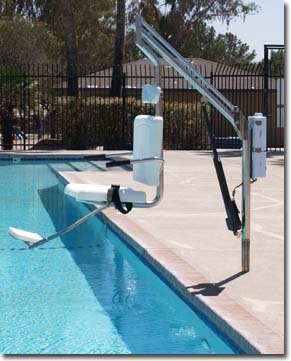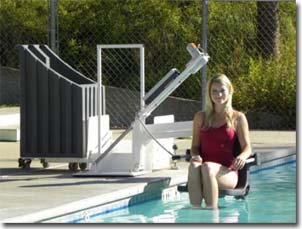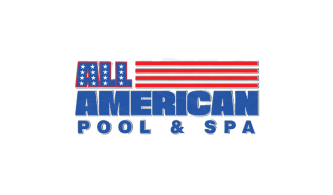Americans with Disabilities Act (ADA) Compliance and the Virginia Graeme Baker Act (P&SS Act).
Americans with Disabilities Act (ADA)
Public and private entities including pools operated by public parks, recreation districts, hotels, motels, fitness clubs, recreational sports clubs, country clubs, campground parks, high schools, universities, water parks, hospitals, and health care facilities. In general, if you provide a pool or spa for use to the general public or you provide a pool or spa at a cost or through membership, you are required to comply.
When are facilities required to comply?
The law went into effect on March 15, 2011, and compliance is required by March 15, 2012. Be a leader in compliance and buy an ADA approved pool lift now to avoid long lead times as the deadline approaches.

What happens if I don’t comply?
The ADA is a federal anti-discrimination law, and as such, violations are addressed in the legal system. By not complying, you are taking the risk of having someone file a complaint with the department of justice and possibly ending up in a lawsuit that could force you to make changes and possibly even assess fines of $55,000 and up to $100,000.

The Solution for ADA Compliance
To accommodate the challenge of ADA compliance, the recommended solution is a pool lift. Pool lifts provide a simple and effective solution while not costing an arm and a leg. Compared to other solutions, the pool lift is the only way to go. To get a free quote on your new pool lift, contact us today.
ADA Compliancy In-Depth
An all-inclusive civil rights law known as the Americans with Disabilities Act (ADA) forbids discrimination due to disability. As of July 23, 2010, there was a new change to ADA regulations compliance, which should take complete effect as of March 15th, 2012. Under Title III of the ADA code, the Department of Justice may enforce the code with a $55,000 penalty for the first violation and $110,000 for any offense after. Any new or reconstructed state and local government facilities need to have ready access to those with disabilities. There is a standard called the ADA Accessibility Guideline (ADAAG) assigned to buildings and facilities, including swimming pools, and are required to be ADA compliant.
In 2002, there were accessibility guidelines issued for new and altered recreational facilities by the Access Board, which were in conjunction with the ADAAG. Once the Department of Justice adopted these guidelines, every newly constructed and altered recreational facility that the ADA covers will be required to be compliant.
There are minimum accessibility requirements for swimming pools and wading pools and spas; however, it is encouraged to exceed the guidelines to increase opportunities for accessibility. It is recommended to incorporate accessibility into a design early in the beginning production plans for safe entry into the water with easier routes and means.
Types of Accessibility and entryways into the water:
There must be a pool lift where the level of water isn’t deeper than 48 inches. This would allow an opportunity for assisting someone in a standing position into the water. Lift seats must be at least 16 inches wide and a minimum of 16 inches from the edge of the pool. The slope cannot be greater than 1:48. Materials used for pool lift seats must avoid corrosion, have a firm base, and be more padded. There must be a clear deck space to provide a person the ability to get close enough to the pool lift seat for easy transfer. There must be no obstruction around the area of the mobility device and the seat. There must be 36 inches wide and an extension forward at least 48 inches located from a line that is 12 inches behind the rear edge of the pool lift seat. Seat height must be anywhere from 16 to 19 inches to accommodate users of a wide assortment of ages and abilities. To provide stability for someone using a pool lift, footrests must be provided to reduce the chance of injury; however, armrests are not required. Lifts must be created so that people can use them without any assistance because it is important that swimming alone can be able to call the lift, so they are not left stranded in the water for long periods of time. A person should operate the lift without any obstruction and use it with one hand, and not need more than five pounds of pressure to control. The submerged depth required is a minimum of 18 inches below water level to ensure buoyancy, allowing for easier entrance or exit. Lift capacity should be at a minimum of 300 pounds and sustain a load that is at minimum 1.5 times the rated load.
Sloped Entries:
The maximum slope permitted is 1:12, which is 8.33% for sloped entries; however, the surface is not required to be slip-resistant. Facilities are encouraged to provide an aquatic wheelchair that would allow access to the water because submerging many mobility devices in water would damage the mobility device and contaminate the pool. The depth of an entry must be anywhere from 24 inches to 30 inches maximum below water level. To become buoyant, this depth is necessary. There must be a landing anywhere from 36 to 60 inches in length below water level, but before an intermediate landing is required, the sloped entry maybe 30 feet at maximum. There must be handrails on both sides of the sloped entries regardless of slope, and extensions are required at the top landing but not at the bottom. There must be 33 to 38 inches between handrails, and handrail height must be anywhere from 34 to 38 inches.
Transfer Walls:
A wall that is along an accessible route that enables a person to leave a mobility device then transferring into a pool or spa is known as a transfer wall. There must be at least one grab bar, which is to be perpendicular to the pool wall and must extend the entire width of the wall, so a person has use of them for support into the water. The top must be 4 to 6 inches above the wall, providing leverage to those that use the bars. Clearance must be at least 24 inches on each side of the bar if there is only one bar provided. Grab bars must be ADAAG compliant. The deck space must be clear by a minimum of 60 inches by 60 inches with a slope of no more than 1:48 at the base of a transfer wall. A person using a wheelchair would be able to turn around as well as access the wall. If two bars have been provided, there must be a space of 24 inches clearance between the two bars. The height of the transfer wall must be from 16 to 19 inches. A transfer wall must be at least 12 inches wide up to a maximum of 16 inches, which provides enough space for someone to sit on the wall surface comfortably and the ability to pivot to gain access to the water. The wall must be at least 60 inches long and must be centered on the clear deck space. The surface of the transfer wall must have rounded edges to prevent injury.
Transfer Systems:
A transfer platform and a series of steps lower into the water are what a transfer system consists of. Each system must have a platform so people can get on and off the system with their wheelchair and must be 19 inches deep by 24 inches wide. The height of a transfer platform must be anywhere from 16 to 19 inches high. The clear deck space must be 60 by 60 inches minimum with a steeper slope than 1:48, which enables a person who is using a wheelchair to turn around into a transfer position. The height of transfer steps must be no greater than 8 inches, but it’s recommended to have shorter heights. The tread depth must be 14 inches to 17 inches with a width of 24 inches. There must be an extension into the water with a minimum of 18 inches below the water level. There must be rounded edges to prevent injuries on the transfer platform’s surface to avoid any injuries. There must be a grab bar or continuous bar at the side of each step on the platform that serves each step. There must be no obstruction by the bar to ensure proper transfer onto the platform. The grab bar’s top gripping surface must be anywhere from 4 inches to 6 inches above the steps. The grab bars must be ADAAG compliant.
Pool Stairs that are Accessible:
Pool stairs need to provide balance and support for a person who is in a standing position into and out of the water when moving on the pool deck. There need to be uniformed riser heights and tread widths of no less than 11 inches required in ADAAG provisions. Open risers are not allowed. The minimum width between handrails needs to be from 20 to 24 inches, intended to support individuals with ambulatory issues among those with disabilities. Handrail extensions at the top landing of the stairs are required, but not required for the bottom landings. Again, ADAAG provisions must be adhered to. There must be a minimum of 34 inches up to no more than 38 inches for the top of the handrail gripping surface. There must be a clear space between handrails and walls measuring 1.5 inches in between.
Water Play Components:
All provisions must be made to comply with the Access Board’s Play Area Guidelines if water play components are available. Requirements for cross slope, running slope, and surface conditions do not have to be adhered to if there are accessible routes, turning spaces that connect to submerged play components, and clear floor spaces provided. A transfer system may be utilized instead of ramps.
Other Elements that are Accessible:
If there is any multi-use facility that includes swimming pools, all designers and operators must adhere to ADAAG provisions required for recreation facilities. These include dressing rooms, locker rooms, sports activity fields, play areas, and saunas.
The Pool and Spa Safety Act was inspired by a 7-year old girl named Virginia Graeme Baker, who became trapped underwater by suctioning a hot tub drain and subsequently drowned. She had been able to swim without any help since the age of 3 years old. In 2002 Graeme had become stuck to a hot tub drain and was not able to get herself free, and even with the efforts made by her mother to free her from the drain, it was too late and Graeme, unfortunately, died from drowning due to a faulty drain cover that trapped her by the powerful suction. It took two men to free Graeme from the suction force, and the force from the men’s pulling caused the drain cover to break from the force.
Graeme’s mother persisted in advocating pool and spa safety. Nancy Baker, as well as Safe Kids Worldwide and the Baker family, lobbied Congress to obtain support in passing a law to change drain covers and other safety devices to prevent injury and potentially death. U.S. Representative Debbie Wasserman Schultz sponsored the statute, passed into law by the President in December of 2007. There was even a national public education campaign brought into fruition to raise public awareness over the prevention of drowning and entrapment. This campaign was known as Pool Safely: Simple Steps Save Lives and was originated by CPSC. If you have not already done so, get your pool P&SS Act compliant today.

